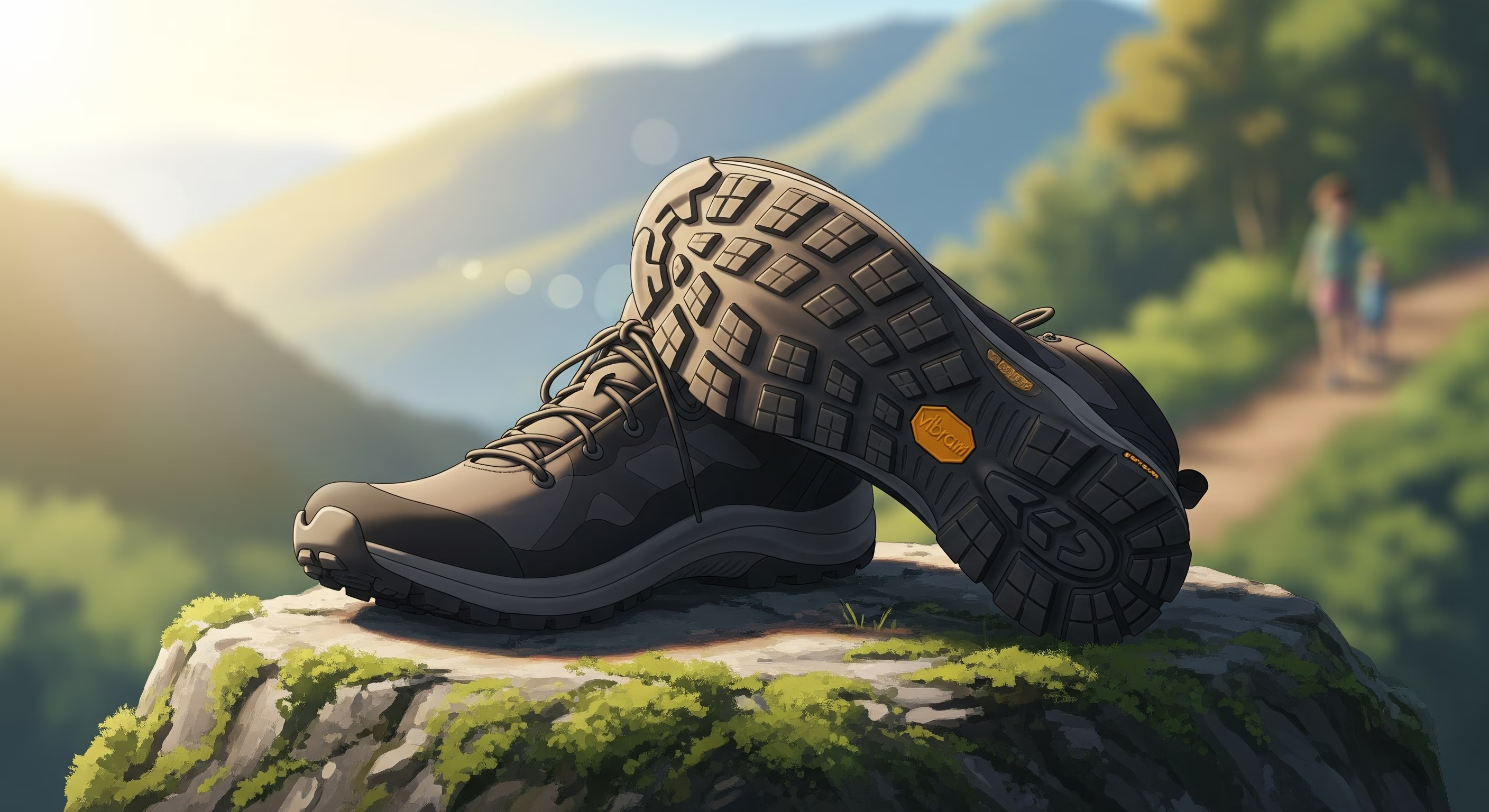INDEX
I’ve felt it myself on the trail.
That deep ache in your arches and the painful pressure points from boots that feel more like ski boots than hiking gear.
For years, the default choice has been stiff boots with hard rubber soles, but for many of us, that’s not the answer.
This guide is for anyone looking for hiking boots no Vibram sole, focusing on comfort and flexibility without giving up crucial support.
I’ll share my personal experience testing boots that are kinder to your feet, especially if you have wider feet or just can’t stand rigid footwear.
We will look at what makes a good sole, how to get stability without stiffness, and review my top five picks that have completely changed how I hike.
The Problem with Stiff Hiking Boots and Finding Hiking Boots No Vibram Sole

Many experienced hikers and hunters have a story about a pair of boots that felt great in the store but became instruments of torture on the trail.
Often, the issue comes down to excessive stiffness.
For example, the common complaint that Crispi guide boots feel too stiff is a perfect example of this problem.
While a rigid boot has its place in technical mountaineering, for most trail use it can cause foot fatigue, blisters, and a lack of ground feel.
Hard rubber compounds, like many traditional Vibram outsoles, don’t always offer the best grip on wet, slick surfaces and can feel unforgiving underfoot.
This led me to search for alternatives that prioritize a more natural foot motion.
⚠️A Note on Boot Fit and Foot Shape
Your foot shape is the most important factor. What feels stiff and painful to someone with flat, wide feet might feel supportive to someone with high arches. Always try boots on at the end of the day when your feet are slightly swollen.
Source: My own trial-and-error experience over dozens of trails.
What is a Good Alternative to Vibram Soles?

When you look for alternatives to Vibram, you’re really looking for different rubber compounds and sole designs that offer a blend of grip, durability, and flexibility.
Many top footwear brands have developed their own excellent proprietary outsole technologies.
These alternatives often use softer, “stickier” rubber formulas. They provide a better connection with the ground and excel on surfaces like wet rock and slick roots.
Here are some of the best non-Vibram technologies I’ve trusted on the trail.
-
Salomon Contagrip®
A family of rubber compounds tailored for different conditions. Known for aggressive lug patterns and fantastic grip on mixed terrain. My go-to for wet and muddy trails in Spain.
-
La Sportiva FriXion®
Another system with multiple rubber types, from ultra-sticky for climbing to balanced for trail running. Offers a superb blend of grip and longevity.
-
Inov-8 Graphene-Grip™
This outsole infuses graphene into the rubber, creating a sole that is incredibly strong, durable, and flexible. I found the grip to be outstanding on rocky scrambles.
-
Altra MaxTrac™
Designed to complement Altra’s wide-toe-box shoes. It provides solid traction with a focus on comfort and a natural feel underfoot. Excellent for long-distance comfort.
Are Stiff Hiking Boots Bad for Hunting? A Hunter’s Perspective

This question comes up often.
The answer really depends on the type of hunting you do.
For stalking game through quiet woods, a stiff boot can be a disadvantage.
But for mountain hunting in rough terrain, where you risk getting caught in a blizzard while hiking, it can be a necessity.
I’ve used both types in different scenarios.
A flexible boot allows you to move quietly and feel the ground under your feet, preventing snapped twigs.
However, a stiff boot provides a stable platform for side-hilling and protects your feet and ankles when carrying a heavy pack over rocks.
Here is a breakdown of the upsides and challenges.
- Superior support for carrying heavy loads and on uneven ground.
- Excellent protection from rocks and rough terrain.
- Provides a stable platform for side-hilling or traversing scree fields.
- Can be noisy, making it difficult to stalk game quietly.
- Lack of ground feel can lead to clumsy foot placement.
- Often heavier and can cause more foot fatigue over long distances.
How to Get Ankle Support Without a Stiff Boot

It’s a common myth that only a board-stiff boot can protect your ankles.
Modern boot design has proven this wrong.
Ankle support comes from a combination of features that work together to hold your foot securely, not just from a rigid cuff.
Understanding these features is the key to finding a supportive boot that is also comfortable and flexible.
It’s about how the boot locks your heel in place and resists twisting motions, not about immobilizing your ankle completely.
This is the most critical part, friends.
A deep, well-formed heel cup stops your heel from lifting or sliding.
When your heel is locked, your whole foot is stable.
This prevents the movement that leads to ankle rolls.
Look for locking eyelets near the ankle bend.
These let you tighten the lower and upper sections differently.
You can get a snug fit around the instep for support.
While leaving the ankle cuff a little looser for comfort.
This means the boot resists twisting.
A small plastic plate, or shank, in the midsole does this.
It gives you stability on uneven ground.
But the boot can still flex naturally from heel to toe.
My Top 5 Tested Hiking Boots No Vibram Sole

After many miles of testing on trails from the Pyrenees to the Caucasus, I’ve found five outstanding boots that deliver comfort, grip, and support without relying on a traditional stiff Vibram sole.
These are my personal recommendations.
Feels like a nimble trail runner but with serious ankle support.
The Contagrip MA sole is fantastic on slick rocks and mud.
Its lacing system truly locks your heel in place, preventing slips.
My top pick for fast-and-light hikes or weekend backpacking.
The wide “FootShape” toe box is a revelation for wide feet.
It’s zero-drop, so it promotes a more natural stride.
The MaxTrac outsole provides reliable, all-around traction.
Incredibly comfortable for long days, it saved my feet on the Camino.
Maximum cushioning makes this feel like walking on clouds.
Uses Vibram Megagrip, but it feels soft and grippy, not stiff.
The rocker shape helps you roll through your stride effortlessly.
Great for hikers with joint pain or those carrying a heavy pack.
This boot offers a snug, performance-oriented fit.
Uses La Sportiva’s super-sticky FriXion White rubber.
The heel brake system is amazing for controlling steep descents.
A perfect choice for technical trails and off-trail scrambles.
The Graphene-Grip outsole is both incredibly tough and flexible.
It’s very lightweight but still provides good protection.
Feels secure and agile on challenging, mixed terrain.
I love this one for fast hiking and mountain running.
FAQs: Your Questions on Flexible Hiking Boots

How do I know if a boot is too stiff for me?
A good test in the store is to try to bend the boot at the ball of your foot. If it takes a lot of effort or won’t bend at all, it’s very stiff. A more flexible boot will bend with moderate pressure, mimicking your natural stride. Pain or pressure points on your arches after a short walk are also clear signs.
Do softer soles wear out faster?
Generally, softer, stickier rubber compounds may wear down slightly faster than hard ones. However, modern technologies like Inov-8’s Graphene-Grip have significantly closed this gap. For most hikers, the improved grip and comfort are well worth a slightly shorter lifespan.
Can I use hiking boots without a Vibram sole for backpacking?
Absolutely. The key for backpacking is a boot with a supportive midsole and a good heel lock, not the brand of the rubber outsole. Boots like the Hoka Kaha 2 or Salomon X Ultra 4 are excellent for backpacking, providing the support you need for a heavy pack with much more comfort than traditional stiff boots.
What’s the best way to break in a more flexible hiking boot?
The good news is that flexible boots require much less break-in time. I recommend wearing them around your house for a few hours, then on short walks around your neighborhood. Pay attention to any hot spots. A couple of short, easy hikes are usually enough to get them trail-ready.
Are all Vibram soles stiff?
No. While many traditional, heavy-duty hiking boots use very stiff Vibram soles, the brand makes many different rubber compounds. The Hoka Kaha 2 GTX, for example, uses Vibram Megagrip, which the article notes is soft and grippy, not stiff. The key is to avoid the board-stiff models if you need flexibility.
What feature is most important for ankle support in a flexible boot?
According to the guide, a secure heel lock is the most critical feature. A boot with a deep, well-formed heel cup prevents your heel from lifting or sliding around. This stabilizes your entire foot and is more effective at preventing ankle rolls than a simply rigid cuff.
Which boot from your list is best for wide feet?
The Altra Lone Peak ALL-WTHR Mid 2 is the top recommendation for hikers with wide feet. It features Altra’s signature “FootShape” toe box, which is anatomically designed to give your toes plenty of room to spread out naturally, preventing cramping and blisters.
Should I choose a stiff or flexible boot for hunting?
It depends entirely on your hunting style. For quiet stalking where you need to feel the ground to avoid making noise, a flexible boot is superior. For mountain hunting on rough, uneven terrain while carrying a heavy pack, a stiffer boot offers better support and protection.
What is the best non-Vibram sole for wet and muddy trails?
Based on Musa’s personal experience, Salomon’s Contagrip® sole is a fantastic choice for wet and muddy conditions. It’s known for aggressive lugs and excellent grip on mixed terrain, making it a reliable option for slick surfaces.
